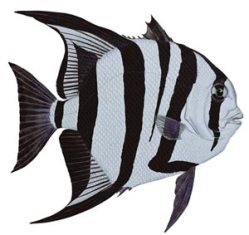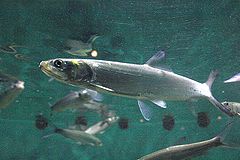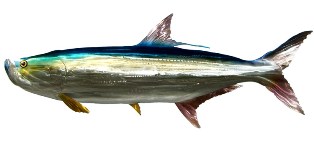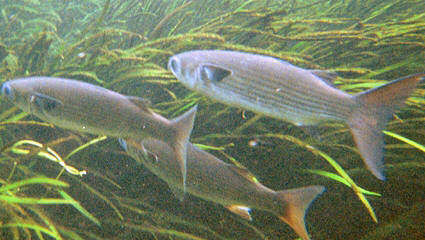Discover Florida Nature
It's time to explore the natural Florida


|
|
|
|
|
 Atlantic
Spadefish (Chaetodipterus faber) The Atlantic
spadefish is found around subtropical reefs, commonly off the coast of
Florida and the Bahamas to southeastern Brazil and the Gulf of Mexico in
depths that range from 3-35 m. This schooling fish is abundant within
the shallow marine and brackish waters of mangroves, beaches, harbors,
and shipwrecks. It is found at depths of 3-35 m. Juvenile Atlantic
spadefish reside in very shallow water, often swimming at an angle,
disguising themselves as dead leaves or mangrove pods to avoid
predation. Adults often school in groups of up to 500 individuals. The
Atlantic spadefish is silvery gray in color with vertical black bars. It
is known and named for its characteristic spade-shaped body, which is
compressed with a short snout. Atlantic spadefish typically grow to
30-45 cm with maximum lengths up to 91 cm and have 2 dorsal fins and 2
anal fins with high anterior lobes. There are also 9 dorsal spines,
21-24 dorsal soft rays, and 17-18 anal soft rays. Juveniles, which are
commonly found in shallow coastal waters, are black in color for greater
camouflage. Atlantic spadefish are frequently curious toward divers and
their bubbles. The Atlantic spadefish feeds on plankton and other
invertebrates. Atlantic
Spadefish (Chaetodipterus faber) The Atlantic
spadefish is found around subtropical reefs, commonly off the coast of
Florida and the Bahamas to southeastern Brazil and the Gulf of Mexico in
depths that range from 3-35 m. This schooling fish is abundant within
the shallow marine and brackish waters of mangroves, beaches, harbors,
and shipwrecks. It is found at depths of 3-35 m. Juvenile Atlantic
spadefish reside in very shallow water, often swimming at an angle,
disguising themselves as dead leaves or mangrove pods to avoid
predation. Adults often school in groups of up to 500 individuals. The
Atlantic spadefish is silvery gray in color with vertical black bars. It
is known and named for its characteristic spade-shaped body, which is
compressed with a short snout. Atlantic spadefish typically grow to
30-45 cm with maximum lengths up to 91 cm and have 2 dorsal fins and 2
anal fins with high anterior lobes. There are also 9 dorsal spines,
21-24 dorsal soft rays, and 17-18 anal soft rays. Juveniles, which are
commonly found in shallow coastal waters, are black in color for greater
camouflage. Atlantic spadefish are frequently curious toward divers and
their bubbles. The Atlantic spadefish feeds on plankton and other
invertebrates. Ladyfish
(Elops affinis) Lady fish are cousins to the larger (much
larger) tarpon. They have some similarities to the tarpon but less
exaggerated and smaller. The Ladyfish is a shallow-water, inshore
species with a long, slender, cylindrical, silvery body, blue
reflections, an oval cross-section, and noticeable scales. The
Ladyfish's mouth has a projecting lower jaw, and it has large eyes. It
has one dorsal fin. The anal fin base is shorter than the dorsal fin
base. The pelvic fins are in the middle of the body, originating
slightly ahead of the dorsal fin origin. The pectoral fins of the
Ladyfish are very low on its sides and just behind the edge of the gill
cover. It has a deeply forked caudal fin. The Ladyfish is a coastal
pelagic species, aggregating close to shore. The Ladyfish reaches 36
inches in length, but is normally between 12 and 30 inches. The Florida
record for a ladyfish catch is four pounds, ten ounces. It is normally
found in the first 25 feet of the water column over sandy bottoms. It is
a twilight predator feeding on small fishes. It is reported in all
Mexican waters with the exception that they appear to be absent from all
oceanic islands. The Ladyfish is viewed as not edible due to the
numerous small bones found throughout its body. Ladyfish
(Elops affinis) Lady fish are cousins to the larger (much
larger) tarpon. They have some similarities to the tarpon but less
exaggerated and smaller. The Ladyfish is a shallow-water, inshore
species with a long, slender, cylindrical, silvery body, blue
reflections, an oval cross-section, and noticeable scales. The
Ladyfish's mouth has a projecting lower jaw, and it has large eyes. It
has one dorsal fin. The anal fin base is shorter than the dorsal fin
base. The pelvic fins are in the middle of the body, originating
slightly ahead of the dorsal fin origin. The pectoral fins of the
Ladyfish are very low on its sides and just behind the edge of the gill
cover. It has a deeply forked caudal fin. The Ladyfish is a coastal
pelagic species, aggregating close to shore. The Ladyfish reaches 36
inches in length, but is normally between 12 and 30 inches. The Florida
record for a ladyfish catch is four pounds, ten ounces. It is normally
found in the first 25 feet of the water column over sandy bottoms. It is
a twilight predator feeding on small fishes. It is reported in all
Mexican waters with the exception that they appear to be absent from all
oceanic islands. The Ladyfish is viewed as not edible due to the
numerous small bones found throughout its body.
 Tarpon
(Megalops atlanticus) The tarpon, a spectacular large fish
which rightly carries the name of Silver King, is unmistakable.
Characteristics include large flat scales up to three inches in
diameter, an elongated dorsal fin, falcate anal fin and large bony
underslung jaw. It has been known to exceed 300 pounds. Little is known
of the tarpons spawning activity or growth. Adult tarpon live in Gulf
open waters, but young tarpon may be found in brackish water around
marsh channels. Adults sometimes may also move up larger rivers that
empty into the Gulf. Tarpon may be found throughout the Atlantic Ocean,
through the Caribbean to Brazil. If you have ever had the privilege of
hooking up on a big tarpon then you know the exhilaration and thrill of
testing yourself in battle against one of the most sought after gamefish
in the world. This distinction is easy to see at first glance as the
tarpon starts a series of spectacular acrobatic leaps in the air that
will have your heart pounding, your rod bending and your drag screaming. Tarpon
(Megalops atlanticus) The tarpon, a spectacular large fish
which rightly carries the name of Silver King, is unmistakable.
Characteristics include large flat scales up to three inches in
diameter, an elongated dorsal fin, falcate anal fin and large bony
underslung jaw. It has been known to exceed 300 pounds. Little is known
of the tarpons spawning activity or growth. Adult tarpon live in Gulf
open waters, but young tarpon may be found in brackish water around
marsh channels. Adults sometimes may also move up larger rivers that
empty into the Gulf. Tarpon may be found throughout the Atlantic Ocean,
through the Caribbean to Brazil. If you have ever had the privilege of
hooking up on a big tarpon then you know the exhilaration and thrill of
testing yourself in battle against one of the most sought after gamefish
in the world. This distinction is easy to see at first glance as the
tarpon starts a series of spectacular acrobatic leaps in the air that
will have your heart pounding, your rod bending and your drag screaming.  Striped
(Black) Mullet (Mugil cephalus)
A black mullet adult probably averages 3 1⁄2 to 4 pounds
year-round. Striped mullet attains an adult size of 18 inches. In the
first year, it grows to 7 - 8.5 inches, and weighs between 2.3 - 4.2
ounces. The females with the blood-streaked yellow roe are always the
biggest mullet. Body shape is cylindrical anteriorally, becoming
somewhat laterally compressed toward the posterior. Black mullet, also
called striped mullet, have bluish-gray or green backs shading to silver
on the sides with distinct horizontal black barrings and white bellies.
Their fins are lightly scaled at the base and unscaled above, and their
noses are blunt. In Florida, striped, or black mullet is the most common
of the mullet species. Differences in fin rays and fin morphology help
separate species. In the summer, black mullet scatter and the schools
are smaller. There could be only 30 to 40 fish in an average size school
then, but there may be 20 or 30 bunches of them on a large flat. In the
fall, the schools may go from 100 pounds of fish (30 fish at 3 1⁄2
pounds each) to massive 2,000-pound schools having maybe 400 individual
fish. As a result, the cooler months from November through March are
often the best times to follow the mullet. The fish migrate offshore to
spawn and fry produced then move back inshore, far up tidal creeks. The
adults follow the fry inshore where they resume feeding on algae and
small marine life forms. Juvenile fishes most common in impounded areas,
around mangroves, in seagrass beds, and offshore throughout the late
fall and winter.
Crystal River Florida is a great
place to find mullet. Striped
(Black) Mullet (Mugil cephalus)
A black mullet adult probably averages 3 1⁄2 to 4 pounds
year-round. Striped mullet attains an adult size of 18 inches. In the
first year, it grows to 7 - 8.5 inches, and weighs between 2.3 - 4.2
ounces. The females with the blood-streaked yellow roe are always the
biggest mullet. Body shape is cylindrical anteriorally, becoming
somewhat laterally compressed toward the posterior. Black mullet, also
called striped mullet, have bluish-gray or green backs shading to silver
on the sides with distinct horizontal black barrings and white bellies.
Their fins are lightly scaled at the base and unscaled above, and their
noses are blunt. In Florida, striped, or black mullet is the most common
of the mullet species. Differences in fin rays and fin morphology help
separate species. In the summer, black mullet scatter and the schools
are smaller. There could be only 30 to 40 fish in an average size school
then, but there may be 20 or 30 bunches of them on a large flat. In the
fall, the schools may go from 100 pounds of fish (30 fish at 3 1⁄2
pounds each) to massive 2,000-pound schools having maybe 400 individual
fish. As a result, the cooler months from November through March are
often the best times to follow the mullet. The fish migrate offshore to
spawn and fry produced then move back inshore, far up tidal creeks. The
adults follow the fry inshore where they resume feeding on algae and
small marine life forms. Juvenile fishes most common in impounded areas,
around mangroves, in seagrass beds, and offshore throughout the late
fall and winter.
Crystal River Florida is a great
place to find mullet. |
|
|
Advertise | Privacy Statement | Dog Encyclopedia | Video |Contact | Alaska Nature |
|